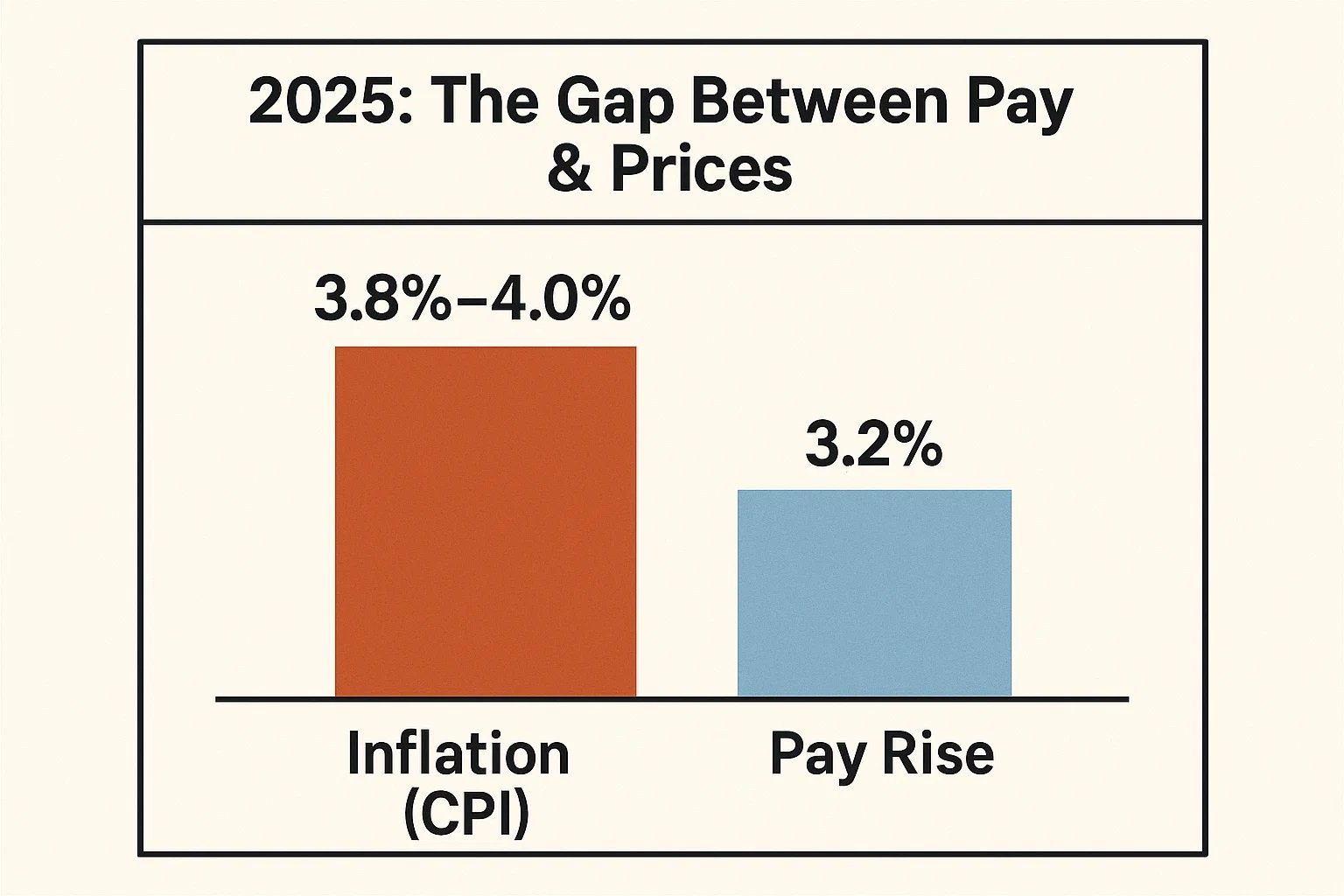No products in the cart.
Ever look at your payslip and think, “What’s happening with my pay this year?” You’re definitely not alone. TAs do so much to keep schools running, and it’s only fair to want clear answers about pay.
For 2026, here’s what we know so far: the lowest pay point (SCP 2) will be removed from April, so anyone on it will move up. Unions and employers will decide the next pay rise in talks next year. Unions (GMB, Unison, Unite) are also pushing for a bold new £15 per hour minimum, though whether that happens depends on funding and negotiations.
One thing is certain: pay will rise again in April 2026, and the debate around how much is going to be a big focus for the year ahead.
In this guide, we’ll cut the jargon, explain what the numbers mean for you, and help you plan ahead. Because your work matters, and your pay should make sense—plain and simple.
TA Pay Rise in 2026: The Short Answer
So, the big question: will TA pay increase in 2026? The honest answer is… yes, but we don’t know by how much yet.
Here’s why: teaching assistants are usually paid on the NJC Green Book scales, which cover most school support staff pay. Each year, unions and employers negotiate a new deal. In 2025, schools gave staff a 3.2% pay rise starting from 1 April — and if they paid it late, they added backpay to cover the difference.
The number will depend on three big factors:
- Inflation – how fast the cost of living is rising.
- Treasury funding signals – how much money the government sets aside for councils and schools.
- Union–employer negotiations – usually held in spring or summer, with any award backdated to 1 April 2026.
There is one confirmed change already: pay point SCP2 will be removed from April 2026, which means anyone on that point will move up automatically, on top of whatever percentage pay rise is agreed.
What the 2025 Pay Deal Means for Next Year
The 3.2% uplift in April 2025 wasn’t just a pay rise—it set a new baseline for all support staff on the NJC pay scales 2025. That increase pushed the typical TA starting salary in 2025 to around £24,413 in local authority schools (though academies may set slightly different figures).
So what does this mean for next year? The 2026 TA pay award will increase these values directly, lifting every point on the scale.
In other words, while we don’t yet know the exact percentage for 2026, we do know you’ll be building on a stronger starting point thanks to the 2025 uplift.
Teaching Assistant Salary Scales in 2026 (Levels 1–3 and HLTA)

If you’re a Teaching Assistant, your pay is linked to the NJC spinal points. Schools and trusts use these points to set salaries for TA Levels 1–3 and HLTAs. This is the national framework for most school support staff.
At the moment, the 2025 pay deal has already set the new starting point for everyone. Here’s where things stand right now:
- Level 1 TA (entry roles): around £23,500 to £24,400
- Level 2 TA (more experienced): around £24,900 to £26,000
- Level 3 TA (specialist or senior): around £26,400 to £28,800
- HLTA (Higher Level Teaching Assistant): around £29,200 to £32,000
Curious to learn more beyond the 2026 update? Don’t stop here. The Open Learning Academy has a fantastic guide that digs into how much teaching assistants earn, how pay is structured, and what it all means in real life. Check it out now!
London vs Other Areas: Who Gets Paid More?
Put simply, TAs in London get paid more. This is because of something called London weighting TA pay. It means extra money is added to your salary depending on where in London you work.
- Inner London pay is the highest.
- Outer London pay is a bit less, but still above the rest of the country.
- Fringe London pay is for schools on the edge of the city, with a smaller boost.
All of these areas still use the NJC spinal points and get the same percentage rise as everyone else. The only difference is that your starting salary is higher if you’re in London.
Why this matters
If you’re a teaching assistant in Inner or Outer London, your pay packet will usually be bigger than someone doing the same job elsewhere. So when the next deal comes in for 2026, the TA pay rise will be the same percentage everywhere, but the cash increase will be larger in London.
Will TA Pay Match Inflation in 2026?

This is the question on a lot of people’s minds: will our pay actually keep up with prices this time?
Looking back at 2025
In 2025, the cost of living went up by about 3.8–4.0% (that’s the CPI inflation rate). Pay only went up by 3.2%. On paper, that sounds close — but in real life, it meant the weekly shop, travel, and bills still felt heavier than before. Many TAs felt like the rise didn’t quite cover the gap.
What could happen in 2026
The good news is that forecasts for 2026 are a bit kinder. The Bank of England and OBR expect inflation to drop to around 2.1%. That’s a much slower rise in prices. If those predictions are right, even a modest pay deal could feel fairer and closer to what staff actually need.
What decides the deal
Here’s the tricky bit: the number isn’t fixed yet. It depends on:
- How much money the government gives to schools
- What unions push for in talks
- And whether inflation really does calm down (or shoots up again)
The Role of Unions in 2026 Teaching Assistant Salary Negotiations
When it comes to pay, you’re not on your own. The big three unions — UNISON, GMB, and Unite — are right there at the table for you. Together, they take part in the official NJC negotiations, where they sit down with the employers (the Local Government Association, or LGA) to argue for a fair deal.
What to expect in 2026
Unions ask for better pay and conditions, employers reply with their offer, and after some back-and-forth, staff vote on the final deal. Members then get their say through consultations and ballots. Your voice really matters here — the more members speak up, the stronger the unions’ hand in talks.
Why it matters
It might sound like dry paperwork, but these negotiations shape your actual pay packet. Campaign updates from UNISON TA pay, GMB NJC, and Unite support staff will be worth keeping an eye on in 2026. Behind the scenes, unions will be doing everything they can to make sure support staff aren’t left behind.
Here’s the tricky part: even if unions win a bigger pay rise, schools still need the money to pay for it. In 2025, the government said there would be little new money. Schools had to cover some of the rise from their existing budgets.
That was tough. Many schools are already stretched, so finding more cash can feel impossible. This same budget pressure will likely affect the 2026 pay award funding too.
On top of that, unions are calling for a minimum pay rate of £15 per hour. It’s a bold demand — but it also makes the question of affordability even sharper.
So in 2026, the talks won’t just be about the percentage rise. They’ll also be about whether schools can actually afford it without cutting other things.
Which TAs Might See Bigger Pay Rises?
Not every pay deal works in the same way. Sometimes the rise is shared out evenly as a percentage. Other times, the deal is a flat cash award or focused on lifting the minimum rate. When that happens, staff on the lower spine TA pay points usually notice the biggest change. A boost at the bottom can feel much larger when your starting pay is lower.
Which TAs Might See Bigger Pay Rises?
In 2026, the biggest increases are most likely for:
- Entry-level TAs (Level 1 roles) on the lowest NJC spinal points
- Staff close to the minimum wage, since unions are pushing for a floor of £15 per hour
- Newer or lower-paid support staff in schools that follow the NJC spine directly
For Level 2, Level 3, and HLTA staff, there will still be a rise — but it probably won’t feel as big, because the same cash increase or uplift makes less difference on a higher salary.
Simple Ways to Boost Your Pay in 2026

You can’t control the national award, but you can make moves that put more money in your pocket:
- Check your grade. Look at your job description. If you’re already doing duties above your grade, ask about a regrading TA review. Schools must pay fairly for the work you’re actually doing.
- Add SEN responsibilities. Many schools pay an SEN allowance for working closely with children with special educational needs. Taking this on can move you into a higher pay bracket.
- Go for HLTA status. Becoming a Higher Level Teaching Assistant (HLTA) is one of the clearest ways to get a pay boost, since it sits on a higher band in most councils and trusts.
- Think location. In London or large MATs, you benefit from extra weighting. That means the same role can pay more simply because of where you work.
- Negotiate extra hours or duties. Use the 2025 NJC scales as your baseline when you discuss pay for added responsibilities in 2026.
Even one of these steps can lift your income — combine two or more, and the difference is noticeable.
Key Dates to Watch for 2026 Pay Updates
Here’s when to keep your eyes open:
- April 2026 → The official start date for the new award. Any rise is normally backdated to this date.
- Spring–Summer 2026 → Negotiations heat up. Expect union offers, ballots, and updates in this window.
- After the deal → Schools update payroll and add backpay. In 2025, the deal came out in July, and arrears were rolled out later.
Tip: Don’t panic if your April payslip looks the same. Once the deal is agreed, backpay means you’ll get what you’re owed.
FAQs About TA Salary in 2026
How much do teacher assistants get paid in the UK?
Most TAs earn £23,000–£32,000 depending on level, hours, and location. London weighting makes pay higher.
What is a TA hourly rate?
Usually £11–£15 per hour, depending on experience, grade, and region.
Can I be a TA with no experience?
Yes. Many schools hire beginners if you show enthusiasm and a willingness to train.
Do teaching assistants get paid well?
Pay is steady but modest. It’s valued more for job satisfaction than high wages.
Why do TAs get paid so little?
Because salaries follow local authority budgets and NJC scales, which are lower than teacher rates.
How many hours is a full-time TA?
Usually around 32–37 hours a week, term-time only.
Do TAs get paid for lunch?
No. Lunch breaks are unpaid in most schools.
What is the 10 minute rule in teaching?
If a teacher is 10 minutes late, pupils wait quietly; TAs may supervise.
Is being a TA stressful?
It can be, especially with high workloads. But many find it rewarding and worthwhile.
Final Thoughts
TA pay isn’t just numbers — it shows your value. In 2026, SCP 2 goes, pay rises start from April, and unions are pushing for £15 an hour.
Yes, the negotiations can feel slow and sometimes confusing, but your pay will rise again in 2026. For many on the lower spine, the changes could bring an even bigger boost. And if you’re keen to add more, there are also practical ways — like regrading, SEN duties, or HLTA status — to lift your earnings further.
At the end of the day, TAs keep schools running. You’re the steady hand in the classroom, the extra support children depend on, and the person who helps teachers teach. Whatever the final figure, one thing is certain: your work matters, and the fight for fairer pay will keep moving forward.




